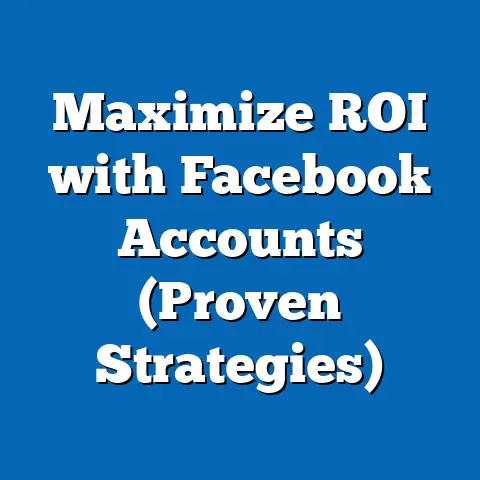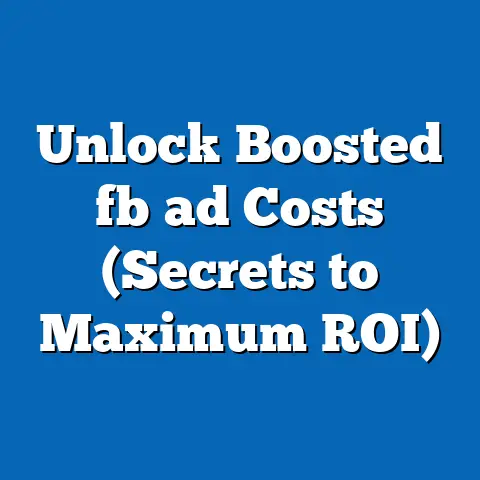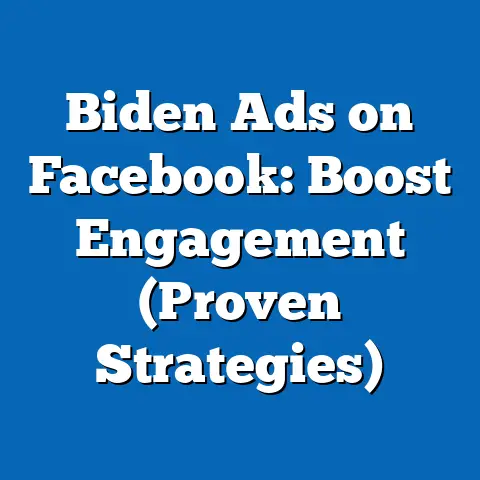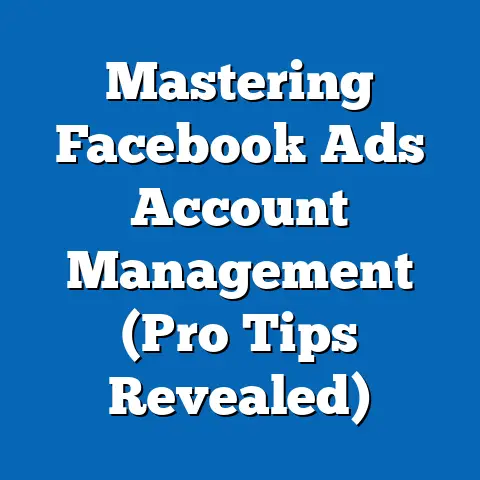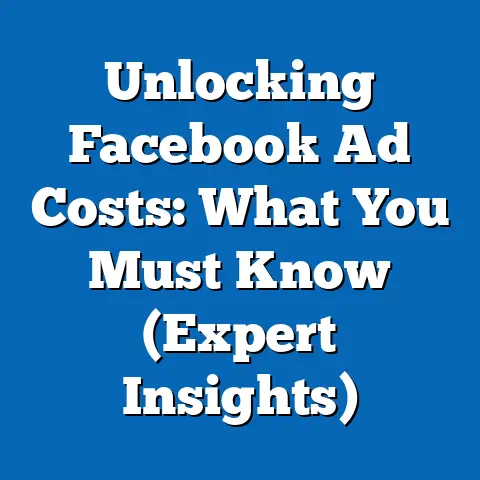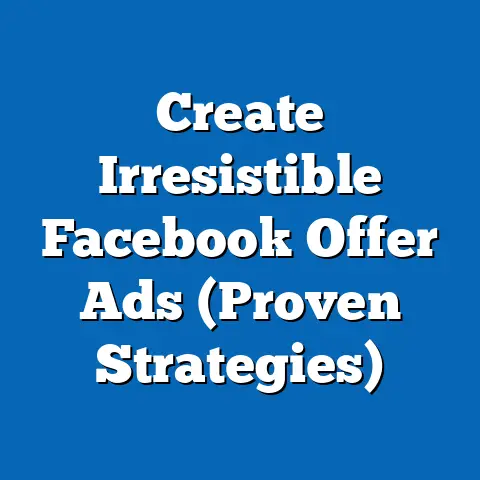Drive Sales with Facebook Auto Ads (Proven Strategies)
As a digital marketing specialist, I’ve seen firsthand how rapidly the advertising landscape evolves. One thing that has consistently proven to be a game-changer is Facebook advertising. And within Facebook Ads, Auto Ads have emerged as a powerful tool, especially for businesses looking to optimize their return on investment (ROI). In fact, according to recent data, businesses leveraging automated ad solutions like Facebook Auto Ads have seen up to a 20% increase in conversion rates compared to those relying solely on manual ad management. This is a significant advantage, and it’s why I’m so passionate about helping businesses understand and utilize this feature effectively.
Facebook Auto Ads are a streamlined, automated solution designed to simplify the advertising process. Instead of manually configuring every aspect of your campaign, Auto Ads use Facebook’s sophisticated algorithms to optimize ad placements, targeting, and bidding. This means you can focus on creating compelling content while Facebook handles the technical complexities of reaching your ideal customers. By the end of this guide, you’ll not only understand the power of Auto Ads but also know exactly how to harness it to drive tangible sales growth.
Section 1: Understanding Facebook Auto Ads
What Are Facebook Auto Ads?
Let’s start with the basics. Facebook Auto Ads are a type of advertising campaign where Facebook’s algorithms take the reins in managing various aspects of your ad campaign. Unlike traditional Facebook Ads, where you manually define your targeting, placements, and bidding strategies, Auto Ads automate these processes based on the goals you set.
I remember when I first started with Facebook Ads, I spent countless hours tweaking targeting parameters and bidding strategies. It was a time-consuming process, and frankly, often frustrating. The introduction of Auto Ads was a breath of fresh air. It allowed me to focus on crafting compelling ad content while the algorithm handled the nitty-gritty details.
In essence, Facebook Auto Ads represent a shift from manual control to algorithmic optimization. You provide the ad creative, set your budget, define your overall objective (like driving sales or generating leads), and then Facebook’s AI does the rest. It continuously learns and adapts to find the most effective ways to reach your target audience and achieve your desired outcome.
Benefits of Using Auto Ads
The benefits of using Auto Ads are numerous and compelling. One of the most significant advantages is the automated targeting. Facebook’s algorithm analyzes vast amounts of data to identify users who are most likely to engage with your ad and convert into customers. This eliminates the guesswork involved in manual targeting and ensures that your ads are seen by the right people.
Another key benefit is the ease of use. Auto Ads simplify the ad creation process, making it accessible to businesses of all sizes, even those without dedicated marketing teams. The intuitive interface guides you through the setup process, and the automated optimization ensures that your ads are continuously improving without requiring constant monitoring.
Time-saving is another major advantage. By automating the ad management process, Auto Ads free up your time to focus on other critical aspects of your business, such as product development, customer service, and strategic planning.
To illustrate the effectiveness of Auto Ads, consider the case of a local bakery I worked with. They were struggling to attract new customers through traditional marketing methods. After switching to Facebook Auto Ads, they saw a 30% increase in foot traffic within the first month. The automated targeting ensured that their ads were shown to people in their local area who were interested in baked goods, resulting in a significant boost in sales.
Who Should Use Facebook Auto Ads?
While Auto Ads offer numerous benefits, they are not necessarily the right choice for every business. However, they are particularly well-suited for:
- Small Businesses: With limited marketing resources, Auto Ads provide an efficient and cost-effective way to reach potential customers.
- E-commerce Brands: Auto Ads can help showcase products, drive traffic to online stores, and increase sales conversions.
- Local Services: Businesses like restaurants, salons, and repair shops can use Auto Ads to attract local customers and generate leads.
- Businesses New to Facebook Advertising: The simplified ad creation process makes Auto Ads an excellent starting point for those who are new to Facebook advertising.
However, if you have highly specific targeting requirements or a complex advertising strategy, you may find that traditional Facebook Ads offer more control and customization. It’s all about finding the right fit for your unique business needs and goals.
Key Takeaway: Facebook Auto Ads are a powerful tool for automating and optimizing your advertising campaigns, especially beneficial for small businesses and those new to Facebook advertising.
Section 2: Setting Up Your Facebook Auto Ads
Creating a Facebook Business Account
Before you can start running Auto Ads, you’ll need a Facebook Business Account. This is separate from your personal Facebook profile and provides access to a range of advertising tools and features.
Here’s a step-by-step guide to setting up a Business Manager account:
- Go to Business Manager: Visit business.facebook.com and click on “Create Account.”
- Enter Your Business Details: Provide your business name, your name, and your business email address.
- Fill Out Your Business Information: Enter your business address, phone number, and website.
- Connect Your Facebook Page: If you already have a Facebook Page for your business, you can connect it to your Business Manager account. If not, you can create a new Page.
- Add Ad Account: If you have an existing ad account, you can add it to your Business Manager. If you don’t have an ad account, create a new one. You’ll need to add payment information to your ad account.
Setting up your Business Manager account is a crucial first step in launching your Facebook Auto Ads campaigns. It provides a centralized platform for managing your ads, Pages, and other business assets.
Defining Your Objectives
Before you dive into creating your Auto Ads, it’s essential to define your advertising objectives. What do you want to achieve with your campaigns? Are you looking to increase brand awareness, generate leads, or drive sales conversions?
Choosing the right objective is crucial because it tells Facebook’s algorithm what you want it to optimize for. Here are some common objectives and how they align with Auto Ads:
- Brand Awareness: If your goal is to increase brand visibility, Auto Ads can help you reach a broad audience and make more people aware of your business.
- Lead Generation: If you want to collect leads, Auto Ads can optimize for lead form submissions or website visits from potential customers.
- Sales Conversion: If your primary goal is to drive sales, Auto Ads can optimize for purchases, add-to-carts, or other conversion events on your website.
I’ve learned that being specific with your objectives is key. For example, instead of just saying “increase sales,” define a specific target, like “increase online sales by 20% in the next quarter.” This will help you track your progress and measure the success of your campaigns more effectively.
Target Audience Selection
While Auto Ads automate many aspects of targeting, you still need to provide some initial guidance to Facebook’s algorithm. This involves defining your target audience based on demographics, interests, and behaviors.
Here are some tips for selecting the right audience for Auto Ads:
- Start with Broad Targeting: When setting up your first Auto Ads campaign, it’s often best to start with broad targeting parameters. This allows Facebook’s algorithm to explore different audience segments and identify those that are most responsive to your ads.
- Leverage Audience Insights: Facebook’s Audience Insights tool can provide valuable information about your target audience, including their demographics, interests, behaviors, and purchase patterns. Use this data to refine your targeting parameters and ensure that your ads are reaching the right people.
- Consider Segmentation: If you have a diverse customer base, consider segmenting your audience into different groups based on their characteristics and needs. This will allow you to create more targeted ads that resonate with each segment.
I once worked with a clothing retailer who was struggling to reach their target audience. After analyzing their customer data, we discovered that their ideal customers were young women aged 18-25 who were interested in fashion, beauty, and lifestyle brands. By targeting this specific audience with Auto Ads, we saw a significant increase in engagement and sales conversions.
Budgeting for Your Campaigns
Setting the right budget is crucial for maximizing the ROI of your Facebook Auto Ads campaigns. You need to allocate enough budget to allow Facebook’s algorithm to effectively optimize your ads, but you also need to be mindful of your overall marketing budget.
Here are some tips for budgeting for your campaigns:
- Start Small: If you’re new to Auto Ads, it’s often best to start with a small budget and gradually increase it as you see positive results.
- Consider Daily vs. Lifetime Budget: You can choose to set a daily budget, which specifies how much you’re willing to spend each day, or a lifetime budget, which specifies how much you’re willing to spend over the entire duration of your campaign.
- Monitor Your Performance: Keep a close eye on your ad performance and adjust your budget accordingly. If you’re seeing strong results, you may want to increase your budget to reach a wider audience. If your ads aren’t performing as well as you’d like, you may want to decrease your budget or pause your campaign to re-evaluate your strategy.
I always recommend starting with a daily budget that you’re comfortable with and then monitoring your performance closely. As you gather data and insights, you can adjust your budget to optimize your ROI.
Key Takeaway: Setting up your Facebook Auto Ads involves creating a Business Account, defining clear objectives, selecting your target audience, and budgeting effectively.
Section 3: Crafting Compelling Ad Content
Writing Effective Ad Copy
Your ad copy is the first thing that potential customers will see, so it’s essential to make a strong impression. Your ad copy should be clear, concise, and compelling, and it should clearly communicate the value proposition of your product or service.
Here are some tips for writing effective ad copy:
- Highlight the Benefits: Focus on the benefits of your product or service, rather than just the features. What problem does it solve? How will it make your customers’ lives better?
- Use Strong Headlines: Your headline is the first thing that people will read, so make it count. Use strong, attention-grabbing headlines that pique their interest and make them want to learn more.
- Include a Call to Action: Tell people what you want them to do. Do you want them to visit your website, make a purchase, or sign up for a newsletter? Use a clear and concise call to action to guide them.
I’ve found that using customer testimonials in your ad copy can be incredibly effective. Hearing from satisfied customers adds credibility and can help persuade potential customers to take action.
Visual Elements
In addition to compelling ad copy, you also need to use engaging visual elements to capture people’s attention. Images and videos can convey emotions, showcase your product or service, and make your ads more memorable.
Here are some tips for creating engaging visuals:
- Use High-Quality Images: Use high-resolution images that are clear, well-lit, and visually appealing. Avoid using blurry or pixelated images.
- Create Engaging Videos: Videos can be incredibly effective for capturing people’s attention and conveying your message. Keep your videos short, engaging, and visually appealing.
- Use Consistent Branding: Use consistent branding across all of your ads to reinforce your brand identity and make your ads more recognizable.
I always recommend testing different visual elements to see what resonates best with your target audience. Experiment with different images, videos, and ad formats to find what works best for your business.
Call-to-Action (CTA) Strategies
Your call to action (CTA) is the final piece of the puzzle. It tells people what you want them to do after they’ve seen your ad. Your CTA should be clear, concise, and compelling, and it should align with your advertising objectives.
Here are some tips for optimizing your CTAs:
- Use Action-Oriented Language: Use action-oriented language that encourages people to take action. Examples include “Shop Now,” “Learn More,” “Sign Up,” and “Get Started.”
- Make It Prominent: Make your CTA prominent and easy to find. Use a button or a visually distinct element to make it stand out.
- Test Different CTAs: Experiment with different CTAs to see what performs best. Try different wording, colors, and placements to find what resonates best with your target audience.
I once worked with an e-commerce client who saw a significant increase in sales conversions after optimizing their CTAs. By switching from a generic “Learn More” CTA to a more specific “Shop Now” CTA, they saw a 20% increase in click-through rates and a 15% increase in sales conversions.
Key Takeaway: Crafting compelling ad content involves writing effective ad copy, using engaging visual elements, and optimizing your call-to-action strategies.
Section 4: Optimizing Your Facebook Auto Ads Campaigns
Monitoring and Analyzing Performance
Once your Auto Ads are up and running, it’s crucial to monitor their performance and analyze the data to identify areas for improvement. Facebook provides a range of metrics that you can use to track your ad performance, including:
- Cost Per Click (CPC): This is the amount you pay each time someone clicks on your ad.
- Click-Through Rate (CTR): This is the percentage of people who see your ad and click on it.
- Conversion Rate: This is the percentage of people who click on your ad and complete a desired action, such as making a purchase or signing up for a newsletter.
By tracking these metrics, you can get a clear picture of how your ads are performing and identify areas where you can make improvements.
I always recommend setting up a dashboard to track your key metrics on a daily or weekly basis. This will allow you to quickly identify any trends or anomalies and take action accordingly.
A/B Testing
A/B testing is a powerful technique for optimizing your Auto Ads campaigns. It involves creating two or more versions of your ad and testing them against each other to see which one performs best.
Here’s a guide on how to conduct A/B tests with Auto Ads:
- Identify a Variable to Test: Choose one variable to test at a time, such as your headline, image, or call to action.
- Create Variations: Create two or more variations of your ad, each with a different version of the variable you’re testing.
- Run Your Test: Run your ads for a period of time and track their performance.
- Analyze the Results: Analyze the results to see which variation performed best.
- Implement the Winning Variation: Implement the winning variation in your Auto Ads campaign.
I’ve found that A/B testing can be incredibly effective for improving ad performance. By systematically testing different elements of your ads, you can identify what resonates best with your target audience and optimize your campaigns accordingly.
Adjusting Your Strategy Based on Insights
The data you gather from monitoring your ad performance and conducting A/B tests can provide valuable insights into what’s working and what’s not. Use these insights to adjust your strategy and improve your ad performance over time.
Here are some ways to adjust your strategy based on insights:
- Refine Your Targeting: If you’re not reaching the right audience, refine your targeting parameters to reach a more relevant audience.
- Optimize Your Ad Copy: If your ad copy isn’t resonating with your target audience, try different headlines, body text, and calls to action.
- Experiment with Visuals: If your visuals aren’t capturing people’s attention, try different images, videos, and ad formats.
- Adjust Your Budget: If your ads are performing well, consider increasing your budget to reach a wider audience. If your ads aren’t performing as well as you’d like, consider decreasing your budget or pausing your campaign to re-evaluate your strategy.
I always emphasize the importance of being data-driven in your approach to Facebook advertising. By continuously monitoring your performance, conducting A/B tests, and adjusting your strategy based on insights, you can significantly improve the ROI of your Auto Ads campaigns.
Key Takeaway: Optimizing your Facebook Auto Ads campaigns involves monitoring and analyzing performance, conducting A/B tests, and adjusting your strategy based on insights.
Section 5: Advanced Strategies for Driving Sales
Leveraging Retargeting
Retargeting is a powerful technique for reaching people who have previously interacted with your business, such as visiting your website, adding items to their cart, or engaging with your content on social media. By showing ads to these warm leads, you can increase the likelihood of converting them into customers.
Here’s how to implement retargeting with Auto Ads:
- Install the Facebook Pixel: The Facebook Pixel is a snippet of code that you install on your website to track user behavior. It allows you to create custom audiences based on website visitors and other actions.
- Create a Custom Audience: Create a custom audience based on people who have visited your website, added items to their cart, or taken other desired actions.
- Target Your Auto Ads to Your Custom Audience: When setting up your Auto Ads campaign, target your ads to your custom audience of warm leads.
I’ve seen incredible results with retargeting campaigns. By showing ads to people who have already expressed interest in your business, you can significantly increase your conversion rates and drive more sales.
Utilizing Lookalike Audiences
Lookalike Audiences are a powerful way to expand your reach and find new customers who are similar to your existing customers. Facebook analyzes the characteristics of your existing customers and identifies other users who share similar demographics, interests, and behaviors.
Here’s how to create and use Lookalike Audiences:
- Create a Source Audience: Create a source audience based on your existing customers, website visitors, or other valuable segments.
- Create a Lookalike Audience: Create a Lookalike Audience based on your source audience. Facebook will analyze the characteristics of your source audience and find other users who are similar.
- Target Your Auto Ads to Your Lookalike Audience: When setting up your Auto Ads campaign, target your ads to your Lookalike Audience to reach new potential customers.
I’ve found that Lookalike Audiences can be incredibly effective for expanding your reach and driving sales. By targeting users who are similar to your existing customers, you can increase the likelihood of finding new customers who are interested in your products or services.
Integrating Facebook Shops and Product Catalogs
Here’s how to integrate Facebook Shops and product catalogs:
- Set Up Your Facebook Shop: Set up your Facebook Shop and upload your product catalog.
- Connect Your Product Catalog to Your Auto Ads: When setting up your Auto Ads campaign, connect your product catalog to your ads.
- Create Product Ads: Create product ads that showcase your products directly through Facebook Auto Ads.
I’ve seen e-commerce businesses experience a significant boost in sales after integrating their Facebook Shops and product catalogs with their Auto Ads. By making it easier for customers to browse and purchase products directly through Facebook, you can significantly increase your conversion rates and drive more sales.
Key Takeaway: Advanced strategies for driving sales include leveraging retargeting, utilizing Lookalike Audiences, and integrating Facebook Shops and product catalogs.
Remember, the key to success with Facebook Auto Ads is to be data-driven, continuously monitor your performance, and adjust your strategy based on insights. By following the strategies outlined in this guide, you can significantly improve the performance of your Auto Ads campaigns and drive tangible sales growth for your business.
Now, I encourage you to implement these strategies in your own campaigns and share your experiences and results. Facebook Auto Ads are a powerful tool, and I’m confident that you can achieve remarkable results by harnessing its potential. Don’t hesitate to experiment, test different approaches, and continuously optimize your campaigns to achieve your desired outcomes. The world of Facebook advertising is constantly evolving, so staying informed and adaptable is crucial for long-term success.
Good luck, and happy advertising!

